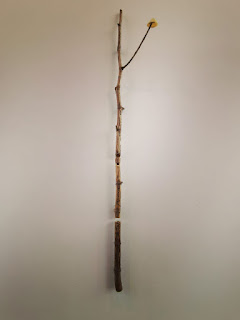Environment. This big word we
encounter everyday. We are assumed to be aware, treat it kindly and with
respect. Our negative impact has become uncomfortably apparent over the last decade,
as reports about climate change have become louder and louder. One reason
things have come this far might be our neglect of the fact that our relationship
with the environment is not one-sided. Nature has an undeniable impact on our identity, whether
personal, national, cultural or otherwise. With our behaviour towards the
environment we do not only directly shape nature itself, but consequently our
own identity. One thing we need to remember is: “We are nature,
too!” as the current Artist in Residence at Uillinn studios,
William Bock points out. However, we seem to be
so disconnected from our environment that we view the natural landscape as an
alien space, a counterpart to our usual life.
On 29 February 2020 William Bock’s
exhibition Land Walks, Land Talks, Land Marks
opened together with Gabhann Dunne’s exhibition Committed to Falling at Uillinn West Cork Arts Centre.
William uses this opportunity to raise our awareness to how entwined our
human world and the natural space actually are.
At the opening event, two artists held
an engaging conversation about both of their works, inviting all guests to join in,
comment and ask questions. William described his approach in using walks
through the landscape as a basis for his current artwork. Over the last year of
his work, which was finalized during his one month residency at the West Cork
Arts Centre, William Bock initiated many walks around West Cork with diverse
groups of people in the locality inclusive of asylum seekers based in
Clonakilty. Along the way, he recorded their conversations and nature’s
sounds and collected different materials found in the landscape - all of which
is exhibited in this current show.
Within the gallery, William Bock
creates a whole world linking the outside space to the inside. By beautifully
installing inconspicuous objects, plants and paintings the artist uses the gallery
as a stage to give a voice to things that are often overheard. This idea is
taken literally during the opening as William asks Composer and Musician Justin
Grounds to play on a flute that was made out of wood collected on one of the
walks and is now displayed in the exhibition. As visitors we are encouraged to
take along Bocks many walks and discover what wonderful things our environment
has to offer. Alongside a beautiful display of reed one can find a delicate
bevy of Fuchsia, a plant from Chile named after the German herbalist Leonhart
Fuchs. Next to it there is a leaf of the Giant Rhubarb or Japanese Knotweed.
Both Fuchsia and Knotweed are widely spread all around West Cork. Once foreign
to this country, they nowadays are a defining feature of Ireland's landscape -
a visualized metaphor for the diversity among West Corks people and their
various backgrounds.
William Bock’s exhibition talks about
our environment and its impact on our identity. His family’s history is one
shaped by migration, flight and movement. Being of Jewish, German and Swedish
Background and having grown up in West Cork William Bock is very connected to
the idea of leaving. But leaving one place also means arriving at another - and
William appears to really have arrived at this place. His works express a deep appreciation
of West Cork’s landscape, an environment that he himself calls his ‘natural
workspace’. Visitors are invited into this workspace and experience
nature, its colours, its sounds, its smell.
Among all the natural materials we
also find relics of human presence: a boot, a mirror, a glove. Here William
expresses that we often have a false idea of nature. There is no romantic
landscape as a counterpart to our human world. Quite on the contrary, we are
inevitably linked to one another. Our concept of nature is a constructed one
and there is no such thing as untouched landscape. Everything surrounding us is
shaped by people. Especially Agriculture has influenced West Corks environment
fundamentally. Therefore, traces of humans within landscape as a part of nature
are the most natural thing. The only question we have to ask ourselves is in
what way we want to shape it. In this exhibition William Bock suggests
that we should try and listen to our real environment, not cling to some
romantic fantasy that only exists in our head.
As the focus draws on the colourful
pigments collected during his walks and later used for the paintings exhibited
in the gallery, people were especially fascinated. To paint with such simple
and original colours is not something you encounter every day. Paint usually
comes in a tube or bottle, at least that is what we are used to. But in fact,
people have used these ‘natural’ materials for centuries. Gall ink, as Bock
explains, is one of the oldest inks ever found in historical writings. Again it
becomes apparent how disconnected from nature we really are. However William
does not point fingers. Rather he opens up the chance of having a share of his
thoughts and rethink one’s own ideas of the environment in a peaceful and homey
atmosphere. As wooden furniture invites us to sit down we can simply listen and
let his beautiful exhibition work on us at its own pace.
Photographs by Stella Gilfert and Maik Gödecke






No comments:
Post a Comment